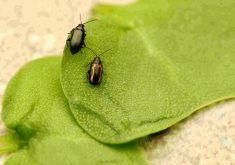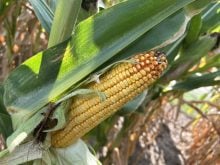Oat fields in central Manitoba are fighting off barley yellow dwarf virus.
“We see it from year to year,” Manitoba Agriculture field crop pathologist Holly Derksen said. “I think this is probably the most severe that I’ve seen it in fields, but that being said, it’s historically been present in Manitoba and in varying levels.”
Four to five cases of the virus have been reported in the Carman and Elm Creek areas, as well as some instances along the Red River. The virus also may take root in its namesake barley or other cereals like wheat.
Read Also

Manitoba boosts stake in cereals centre to $23.5 million
Premier Wab Kinew said the additional project funds will help ‘Trump-proof’ the provincial economy.
Derksen added it is unclear if there are other, unreported, cases.
Early stages of the virus cause green to fade from leaf edges and tips, often leaving a central green strip, according to the July 26 Manitoba Insect and Disease Update. In oats, the discolouration often appears red, pink or purplish.
Advanced infections cause premature ripening, stunted plants and unfilled or missing grain heads.
“It would be nice to catch it, obviously, before it got to that point where your whole plant is affected,” Derksen said.
Yield impact may vary according to the severity of the infection, she added.
“It does seem like this year there are some bigger patches and when it is a severely infected plant, you will have blasting of the florets and then, of course, you will not have seed production,” she said. “It really depends on the incidence in the field, but if there are big patches that are affected, there could be some significant yield loss.”
Yield loss may be limited if plants are more mature when infected, Manitoba Agriculture says. The provincial government cites yield loss if infection occurs before the four- or five-leaf stage, while plants infected after the boot stage show “few or no symptoms.”

The province also notes that susceptibility will vary according to variety, although no truly resistant cereal varieties are available.
Look down
Farmers should keep their gaze close to the ground while insect scouting to prevent the disease, Manitoba Agriculture entomologist John Gavloski said.
The infection is solely aphid-borne and is often spread by the oat-birdcherry aphid, which may feed on an affected plant before moving to healthy vegetation. The “dull olive-green” insect, as described by July 26 update, frequents lower leaves and stems.
“Generally, we still use a 12- to 15-aphid-per-stem threshold, but if it’s early in the season and it’s mainly the oat-birdcherry aphid, people might want to go a little bit lower than that, although we don’t have a separate threshold for that aphid,” Gavloski said.
Other aphids could hypothetically carry the infection, he added, although not as efficiently. The English grain aphid, the florescent-green insect often found on cereal heads, is not considered a major risk.
There have been more oat-birdcherry aphids than average this year, Gavloski said. Populations vary year to year as neither the oat-birdcherry aphid nor English grain aphid overwinter in Manitoba and are instead blown in every year from the southern United States.
“We always see some, but this year they were more visible than normal,” Gavloski said.
The virus must be transmitted by aphids and does not spread through soil or seed, according to Manitoba Agriculture, although the virus can overwinter in winter cereals.
















